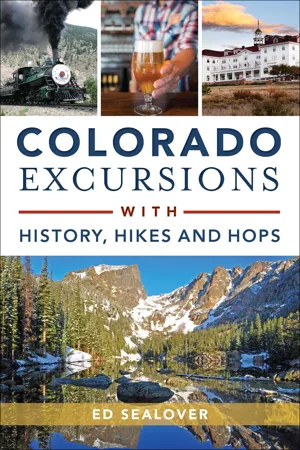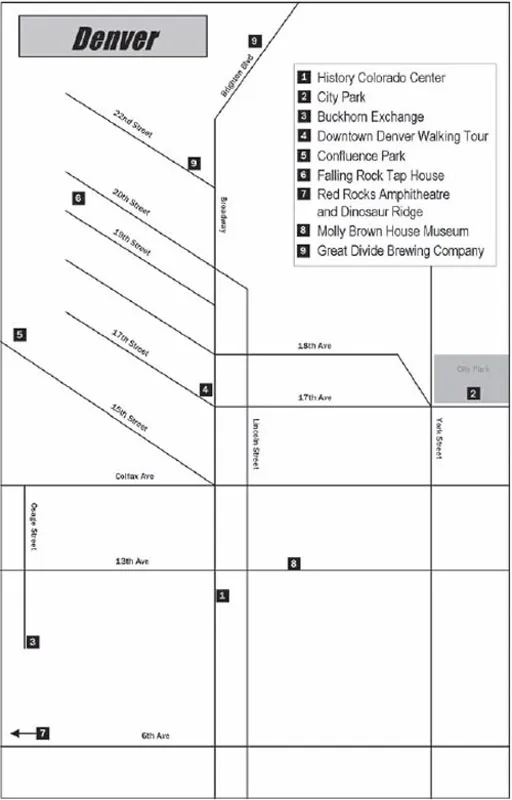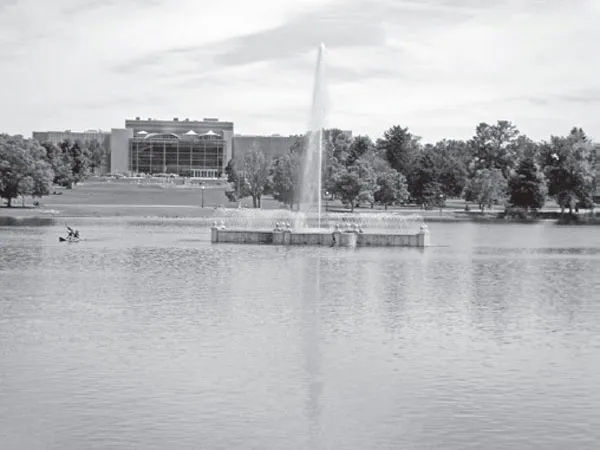![]()
TRIP #1
DENVER
![]()
DAY 1
INTRODUCTION TO DENVER AND COLORADO
HISTORIC SITE: HISTORY COLORADO CENTER
1200 Broadway, Denver / 10:00 a.m. to 5:00 p.m. daily / www.HistoryColorado.org
Though Colorado became a part of the American story much later than many historic East Coast states, its preserved history stretches back further than most parts of the country. And this museum, opened in 2012 to replace an outdated predecessor, tells not just the stories that many around the country know but also the too-often-overlooked niches of history that have given “Colorful Colorado” a meaning beyond the vibrancy of its landscape.
A digital timeline in the soaring atrium initiates visitors to the breadth of activity here, from formation of the Rocky Mountains to events like the 2008 Democratic National Convention. Near it are H.G. Wells–style time machines that allow the visitor to dial up stories ranging from those of the historic Cheyenne Dog Soldiers to gonzo journalist Hunter S. Thompson’s ill-fated 1970 run for Pitkin County sheriff.
“Colorado Stories” walks visitors through some four hundred years of history with a focus on eight places in time. An exhibit on the mines of Silverton literally places you inside the engines of commerce that drew people to the state in the nineteenth century. A section on Lincoln Hills, an African American mountain resort founded in 1922, lets you examine a side of Colorado rarely seen. And an area highlighting Steamboat Springs—home to more Winter Olympians than any city in America—explains why skiing was so important to the development of the state and sends visitors on a simulated ski jump.
Located in Denver’s Golden Triangle neighborhood, the new History Colorado Center opened in 2012. Frank Ooms.
Colorado’s story is one based on humans interacting with the environment. The “Living West” exhibit explains why people settled at Mesa Verde in southwestern Colorado—and then disappeared. It tells of Colorado’s often-overlooked part in the Dust Bowl, immersing visitors in the terrifying Black Sunday storm of 1935. And it explains why forest fires are playing a major part in recent state history.
With 15 million pieces in its collection, including iconic Works Progress Administration dioramas depicting the settlement of Denver, the museum has a constantly rotating schedule of special exhibits, plus standing features on Denver oddities and an early twentieth-century homesteading town on the Eastern Plains. It would take you a month to visit all of Colorado’s highlights; History Colorado Center will give you the overview, however, in a few hours.
NATURAL SITE: CITY PARK
2001 Colorado Boulevard, Denver / Open around the clock / www.denvergov.org/parks
Denver respects its natural beauty by preserving a significant number of public spaces. Washington Park in the south-central city is a joggers’ and picnickers’ paradise. Cheesman Park, east of Capitol Hill, is a picnic hot spot built on a former graveyard. And the best combination of beautiful walks and educational attractions exists in east Denver at City Park.
The Dr. Martin Luther King Jr. I Have a Dream Monument in Denver’s City Park honors civil rights pioneers from different centuries. Author photo.
Denver Museum of Nature & Science stands in the background of the electric fountain in City Park’s Ferril Lake. Author photo.
Laid out in the 1880s and 1890s, the 320-acre park is home to two of the city’s most visited tourist destinations. Denver Zoo, with its beloved polar bears and elephants, sits on the northern side of the park. The Denver Museum of Nature & Science, which specializes in everything from paleontology to Egyptology, marks the eastern end at Montview and Colorado Boulevards.
City Park’s centerpiece is Ferril Lake, a quaint twenty-four-acre body of water that was known as Big Lake before being renamed in 1996 for poet, newspaperman and native son Thomas Hornsby Ferril. In the 1880s, passengers cruised it in swan boats—pedal-powered likenesses of the bird that scared the daylights out of the native geese. Today visitors can rent smaller pedal boats, kayaks or stand-up paddle boards.
Standard bicycles and surrey bikes also are available to get a full view of the park, or you can meander the three-mile Mile High Loop, a paved path that marks the spots exactly 5,280 feet above sea level.
The two-story, Spanish-style pavilion at the west end of Ferril Lake featured white-jacketed waiters serving meals at the turn of the twentieth century—and also held two jail cells for unruly parkgoers. It’s now the focal point of a summer jazz concert series.
The Dr. Martin Luther King Jr. I Have a Dream Monument just west of Ferril Lake honors civil rights leaders stretching from Frederick Douglass to King and features timelines of progress, as well as the diagram of a slave ship. Wellington Webb, Denver’s first African American mayor, dedicated it in 2002.
Just south of the zoo is Duck Lake, the largest of eight other lakes in the park and home to colonies of black-crowned night herons and doublecrested cormorants. So many birds make homes of the trees around the lake that the atmosphere feels Hitchcockian at times.
Many tucked-away gardens make pleasant resting spots. Most intriguing may be the Burns Garden northwest of the pavilion, designed in the French broderie style and featuring both a statute of Scottish poet Robert Burns and three Civil War cannons.
DRINKING SITE: BUCKHORN EXCHANGE
1000 Osage Street, Denver / 11:00 a.m. to close weekdays, 5:00 p.m. to close weekends / www.buckhorn.com
Buckhorn Exchange holds Colorado’s liquor license number one and is the oldest restaurant in Denver. But the bar and eatery that’s hosted five presidents didn’t gain its international fame until it decided to serve its now signature dish: fried bull testicles.
In operation since 1893, the Buckhorn Exchange wears its reputation for serving the meat of exotic animals with pride. Courtesy of Buckhorn Exchange.
Diners at the Buckhorn Exchange eat under the watchful eyes of wildlife of all sorts, some shot by original owner Henry “Shorty Scout” Zietz. Courtesy of Buckhorn Exchange.
Those Rocky Mountain oysters, which co-owner Bill Dutton calls the “original sack lunch,” are not just a gimmick; they’re among the best-selling items on an exotic game menu that also features smoked rattlesnake, fried alligator tail and the occasionally available ostrich and yak. Just south of downtown, the Buckhorn is such a destination for out-of-towners that the menu is printed in five languages.
Henry “Shorty Scout” Zietz opened the Buckhorn in 1893 after a career that included scouting with Buffalo Bill Cody and riding for the Pony Express. He maintained such a reputation as a guide that Teddy Roosevelt parked his presidential train at the rail stop across from the Buckhorn in 1905 and had Zietz lead him in search of game.
Zietz’s treasures now pack the walls of the first and second floors. There are mountings of African gazelles, a two-thousand-pound buffalo and a twoheaded calf. More than 120 antique firearms are displayed in glass cases. Souvenirs from famous visitors—including the flag from Roosevelt’s train and a fishing license used by John F. Kennedy during a Colorado vacation—are tucked into corners. And Native American photos and artifacts hang prominently as a sign of Zietz’s friendship with the tribes.
Zietz ran the Buckhorn until his 1949 death and was famous for his hospitality, including his tradition of giving a free beer to any miner who cashed his paycheck there. His son sold the restaurant in 1978 to a group of investors who sought to preserve its lore and history while turning a steak-and-potatoes joint into one serving now-exotic dishes that once were the staples of the Old West.
In recent years, it’s also become a haven of craft beer and whiskey, offering a dozen Colorado-made brews and another dozen small-batch whiskeys, along with extensive wine and single-malt Scotch lists. Its signature drink is the Buffalo Bill Cocktail, which the showman used to order himself—bourbon and apple juice. Dutton thinks it’s only appropriate.
“It’s the same thing as with our menu,” he said. “People like to ask: What do you have that’s unique to Colorado?”
![]()
DAY 2
DOWNTOWN DENVER
HISTORIC SITE: DOWNTOWN DENVER WALKING TOUR
One of Denver’s toughest early moments also was one of its most fortunate. Just five years after the city’s 1858 founding, much of the central district—a collection of closely crammed wooden buildings—burned, destroying seventy businesses. City leaders decided to rebuild in brick. And because of that, the ever-changing downtown area is lined today with nineteenth-century structures that tell the tale of Denver’s past.
For a proper walking tour, begin at the Brown Palace at Seventeenth Street and Broadway and then follow this guide northwest, away from the capitol.
Built in 1892, the Brown Palace has hosted every president of the past 110 years except Calvin Coolidge and Bara...






